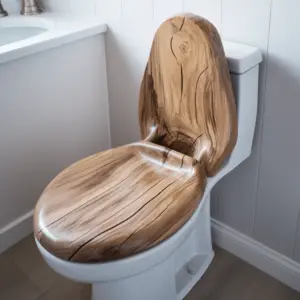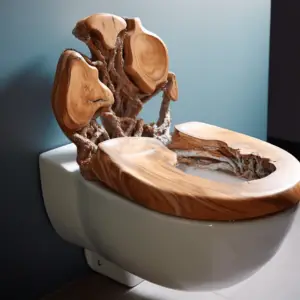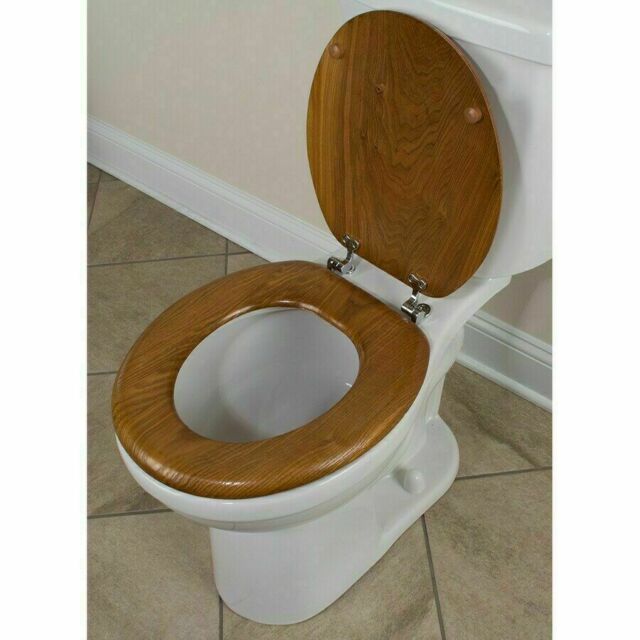If you’re planning to purchase toilet seats, there are many options in the market today. Choosing a wood vs plastic toilet seat depends mainly on your taste. Wood toilet seats are more comfortable and warmer yet tricky to clean.
On the contrary, plastic seats are versatile, easy to maintain, clean, and durable. Although they are uncomfortable, colder, especially during winter, and contain a lower weight tolerance. They’re also susceptible to urine stains.
If you’re considering what type of seat you should install, the most common ones are plastic and wood. However, getting an in-depth review of the two will enable you to decide which one suits your needs. We share with you their pros and cons.
Types of Wood Toilet Seats
There are two types of wood seats, namely.
Enameled wood – wood that has been coated with Enamel making it look like plastic while giving it a smooth finish
Wood veneer- They are made of wood strips created around a wood core, allowing you to view the natural grain.
Therefore, in this comparison, we will feature Enameled wood seats to plastic toilets, followed by a similar comparison between wood veneer toilet seats. Let’s get on with it.
Table of Contents
Enameled Wood Seat vs Plastic Seats

Comfort and Style
Enameled seats comprise extensive benefits of both the wood veneer and plastic toilet seats. They retain more heat which makes them feel warmer in winter, unlike plastic toilet seats.
Additionally, enameled seats have a premium and homey feel, for they are heavier, unlike plastic ones, which are lightweight with a cheap feel sometimes.
Lastly, enamel toilet seats are white, which makes them blend in well with the modern décor, unlike wood veneer seats.
Weight
Enameled wood seats possess a wood core and thus contain a lot of added weight which is good because it makes the seat last long and feel extra premium. Although the toilet weight has its downside as it may slam down on the bowl, causing a racket or even damage.
Plastic seats are the direct opposite of the enameled wood seats.
Hygiene
Due to the enamel finish, the enamel wood seats have a smooth-porous surface, making them super easy to clean, just like plastic.
Consequently, the enamel wood seats may wear or crack over time, leaving the wood core exposed, forming ground for germs to manifest and eventually rot if the damage is fixed.
However, the Enamel doesn’t crack easily, so worry less.
Durability
The enamel coating on the seats helps them from warping, cracking, or other scratches compared with wood veneer seats.
Enamel seats are more durable than plastic seats because their weight gives you the best of both worlds.
Versatility
Both types of seats are versatile. They come in a broad scope of shapes and sizes.
You can even get the soft relative option with an enameled wood seat, but they are costly.
Price
Enamel wood seats come in a vast spectrum of prices, with some being more expensive and others at a close price to plastic chairs.
The seat quality determines the price range and whether you want a soft, closed toilet seat. Nonetheless, the wood enamel toilet seat resembles a regular wood veneer seat.
Wood Veneer Seats vs Plastic Seats
Comfort
Plastic seats are colder for they don’t keep any heat while the wood veneer traps heat, keeping your toilet warmer.
Therefore, if your home tends to get chilly during cold seasons, get yourself some wood veneer for extra comfort.
Hygiene
Wood can be tough to clean as its material is porous. It traps the things it comes into contact with, such as urine, and harbors the smell if it happens regularly.
However, plastic contains a smooth surface which is easy to disinfect and clean. It is perfect if you have minors at home who haven’t learnt how to use the toilet fully.
Style
Different people have different tastes and styles. Wood toilet seats can sit in with rustic décor and offer a warmer, more inviting feel, with the plastic toilet seat providing a sleeker, modern look.
Durability
Wood seats may be heavier with more comprehensive strength, but they’re susceptible to warp and crack in extreme heat and humidity. They are installed using metal hinges which are longer-lasting than the substitutes.
Plastic is no exception to warping and cracking although small plastic pieces such as hinges break easily, they are suitable for places with high humidity.
Versatility
Plastic seats are available in various styles and shapes compared to wood seats. It has a soft–closing quality meaning it is quiet to avoid loud bangs when falling.
Wood seats are heavier than plastic ones, making it pricier but more complicated to get a soft close solution.
Price Wood veneer seats are costly for you to pay for their look and aesthetic.
Plastic seats are perfect if you’re on a tight fixed budget.
Wood Toilet Seats Pros and Cons
Pros
| Cons
|
Plastic seats pros and cons
Pros
| Cons
|
Things Involved In Choosing a Toilet Seat
Due to the multiple options to choose from, we will share some factors to aid you in confining down your search and getting the best toilet seat for the toilet. Take a look
Comfort: here, you need to look at the seat’s shape with the elongated seat considered more comfortable than round ones, the materials the toilet seat is made up of, an ergonomic design, and a bathroom seat that doesn’t wiggle around when you sit on it.
Cost: There are toilets of different range spectrum from small to large. Therefore, finding your choice shouldn’t be an issue. What matters most is what you consider essential among these factors.
Material: Many materials make toilets, but plastic seats and wood ones are the most common. Find more information from the above sections. Others are ceramic, Brass, Vinyl, and Stainless Steel.
They all have benefits and shortcomings, so the decision lies with you.
Durability: a wooden seat is more durable than one made of plastic. Besides, wooden toilet seats don’t scratch easily or crack. Nonetheless, there are plastic toilets of long-lasting quality too. Find more from the customer’s review before settling on your choice.
Appearance: There are immense options to blend with your décor. The possibilities are unlimited.
Which One Is Better: Plastic Seats or Wood Toilet Seats?

Your personal preference means a lot as it determines your choice. Whether your choice is wooden toilet seats or plastic seats, the proper care and maintenance contribute to the durability of any toilet seat.
Finally, use the information in the comparison section to wisely decide your toilet seat needs. Hopefully, you find this piece helpful.


